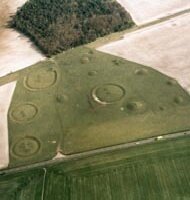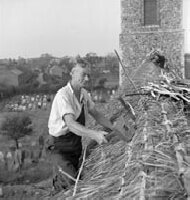National Monuments Record


Background
The National Monuments Record (NMR) is part of English Heritage and provides services based on a range of archive and information resources, including over 10 million archive items, photographic prints, plans, drawings reports, and database records. These records have been created by national institutions concerned with national survey programmes and projects, or acquired by them from others. Chief among these institutions are the former Ordnance Survey Archaeological Record, the former National Buildings Record, the National Library of Air Photographs and the archives and information created and acquired by the former Royal Commission on the Historical Monuments of England which merged with English Heritage in 1999. Extensive external acquisitions include photographs and other records from Country Life, Bedford Lemere and Co, the Royal Air Force, the Buildings of England and the English Courtauld Collection.
The NMR is renowned for photographs of buildings and for air photographs and is also responsible for the creation of a significant new archive of photographs of listed buildings through the Images of England project.
The NMR also maintains a major national database (the Inventory) of indexed descriptions of monuments and buildings, including maritime records, which is linked to computerised mapping and includes bibliographic records. This record contains 400,000 site specific records and 170,000 activity records. Subject to the enhancement of information systems, the NMR also aims to provide access to databases of statutorily protected sites such as listed buildings and scheduled monuments.
The archives repository and main public service activities are based in the National Monuments Record Centre (NMRC) in Swindon, Wiltshire, which is a recognised place of deposit under the Public Records legislation and has high environmental standards for the storage of photographs and other archives. The NMR aims to devise and maintain services, which reflect varied requirements, based on user feedback.
Relationship with other records
The NMR works in partnership with a number of other archive and record holding bodies. The National Archives (Public Record Office) is responsible for the policy and administrative records of English Heritage. The British Architectural Library of the Royal Institute of British Architects is the principal archive of architects’ collections, although the NMR has some records of architects who specialised in conservation. At a local level, there is a network of local authority record offices. There are also 100 local authority Historic Environment Records (HERs), formerly known as Sites and Monuments Records (SMRs) (see separate section on Historic Environment Records).
The NMR works closely with the parallel NMRs in Scotland and Wales on a range of archives and access projects, and operates in a UK, European and international context especially for common standards on the management of records of the historic environment. The NMR represents English Heritage in the UK Historic Environment Information Resource Network (HEIRNET).
Services
Conventional Services - Around 18,000 people use our search room and remote enquiry service each year. Almost half of these are members of the general public, consulting material as part of local or family history research. In common with other archives, the majority are aged 45 or over, with less than 2% of non-white ethnicity. One third are commercial users, ranging from picture researchers and estate agents to consulting engineers, archaeological units and conservation architects. The remainder includes academics, local authorities, and heritage organisations. Whoever they are, most of our users wish to consult original archive material, namely photographs, measured drawings and survey reports. Many of them reproduce our material in publications or other media, thereby reaching a secondary and much larger audience.
Digital Services - Because our visitor and remote enquiry service is labour-intensive, we have sought to reach a bigger, and wider, audience by developing online resources. Our new online picture library – Viewfinder – which provides online access to 20,000 images, received more than 250,000 visits in the past 3 months. In 2002/3, 3,756,275 images were viewed on the Images of England site. As part of Images of England we are developing downloadable image packages and other resources for teachers. Last year, NMR images on The Living Library web site were accessed 40,000 times for use in schools.
Data supply to support policy and research - Although the majority of our users wish to consult original archive material, the NMR plays a major role in providing a solid evidence base for the historic environment that not only informs policy and decision-making but also enables good quality research. Historic environment data is supplied to government departments and agencies, other national organisations and amenity societies, local authorities, commercial organisations and private individuals in response to enquiries, as well as being available through online services such as MAGIC (Multi-Agency Geographic Information for the Countryside), which is hosted by Defra. The NMR also continues to supply the Ordnance Survey (OS) with heritage information for inclusion on OS digital and paper mapping. This ensures not only that decision makers using mapping products have access to historic environment information but also that the NMR is reaching a much wider public audience using maps for both leisure and education purposes.
Outreach - Our outreach programme, used by about 5,000 people each year, teaches people how to use NMR material most effectively in their work or personal research. It is also piloting ways of reaching new audiences with its community project, such as the Living Story project.
Specialist guidance and advice
The NMR provides specialist advice and guidance to a range of users, which include other national heritage organisations, local authority HERs, local and national thematic projects, researchers, students etc.
Through its Data Standards Unit, the NMR has developed a lead role, within England, the UK and internationally, in developing and delivering data standards based on common heritage data problems and research. The development and application of data standards are vital to ensure that users can access and retrieve data within and across information systems. As well as developing standards and producing technical advice notes, which are available via the web site, the NMR is proactive in sharing its expertise with others through the maintenance of an advice service, participation in projects, the delivery of specialist training and staff secondments.
At a UK level, the NMR is an active participant with local authorities in the Forum on Information Standards in Heritage (FISH), which aims to co-ordinate, develop, maintain and promote standards for the recording of heritage information. In partnership with others, it has developed recording standards such as the Monument Inventory Data Standard (MIDAS) and vocabularies such as the Thesaurus of Monument Types, both of which are recognised national standards. In these areas, the NMR works closely with the NMRs for Scotland and Wales. At an international level, the NMR has represented the UK in a range of projects that aim to develop European heritage networks and standards.
As part of its standards and training role, the NMR acts as a key national liaison point for local HERs for whom it provides a range of specialist services (see separate section on HERs). In addition the NMR provides a general advice service, organises forums, manages e-mail discussion lists and publishes newsletters and guidance notes.
Using the National Monuments Record
For those who would like to find out more about the historic environment from prehistory to the present, the NMR’s Outreach team runs workshops and tours designed to help make the best use of our material for research, work needs or personal interest. All are welcome to consult our records, including our excellent reference library, by visiting our public search room in Swindon, address:
National Monuments RecordThe Engine House
Fire Fly Avenue
Swindon SN2 2EH.
Tel:
Fax:
Visitor information for the NMR
Further Information
Publications:
Clubb,N,2002, The National Record in England: Unlocking the Past through Partnership, IFA Yearbook and Directory, 2002, pp20-21
EH Consultation Paper, 2003, Review of the National Monuments Record
EH NMR Review (forthcoming)
RCHME, Annual Report1998/9,A History and final report,
Sargent,A, 2001, ‘RCHME 1908-1988: A History of the Royal Commission on the Historical Monuments of England’, Transactions of the Ancient Monuments Society, vol. 45, pp 57-80
Websites:
National Monument Record website
Viewfinder image resource
Images of England images and descriptions of listed buildings
Pastscape user friendly access to a streamlined version of the principal NMR database.
What's New?
-
The National Heritage List for England is now live on the English Heritage website.
-
Welcome to the HER21 page. This page offers access to the full suite of HER21 project reports.
